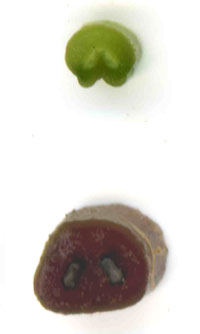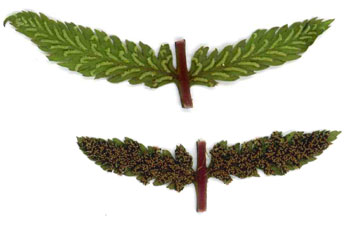|
Hardy Fern Home A. niponicum resources
All Ferns � Woodsiaceae �� Athyrium
�Other Genera
|
| Athyrium niponicum | ||
Japanese painted fern | ||
|
Etymology
Niponicum is the Latinized word for Nippon or Japan.
Description
Rhizome: long-creeping, about 3 mm diam., also listed as short-creeping, scaly.
Frond: 70 cm high by 25 cm wide, deciduous, monomorphic, blade/stipe ratio: 1:1 or a little more. Stipe: straw-colored, or sometimes red-purple, scales lanceolate, 4--6 mm long, 1 mm broad, membranous, entire at margin, pale brown, falling early, vascular bundles: 2, peanut-shaped, at stipe base, uniting to a u- or v--shape above. Blade: 2-pinnate pinnatifid, abruptly narrowed toward terminal pinna-like apex, lanceolate, the uppermost pinnae sessile, sharply reduced, herbaceous, soft, scales on rachis lanceolate, sparse. Pinnae: 10 to 20 pair, opposite to alternate, anadromous at base of blade, becoming isodromous above, long-stalked, lanceolate, long-tapering; pinnules lanceolate, obtuse to pointed at apex, 1--3 cm long, 3--15 mm broad, longest below the middle of the pinna; costae grooved above, continuous from rachis to costae to costules; margins serrate to deeply pinnatifid; veins free, not reaching the margin, not easy to see without a lens. Sori: varying in shape, in a basic herringbone pattern, merging at maturity, medial, between midrib and margin, indusium: shape as for sori, whitish, shriveling, attached along the vein, sporangia: dark brown, maturity: summer. Dimensionality: lowest pinnae bending forward, above the plane of the blade. Culture
Habitat: lowlands, shade.
Distribution: China, Japan, Korea, Manchuria.
Hardy to -35�C, USDA Zone 3.
Distinctive Characteristics
Most plants in commerce are the selection 'Pictum', not really a selection, but a whole range of variations on silver and maroon shadings to the costae and lamina.
Synonyms
Asplenium niponicum Mett. Asplenium uropteron Miq. Athyrium uropteron (Miq.) C. Chr. Athyrium goeringianum (Kunze) Moore |
|
|

Athyrium niponicum. Two peanut-shaped vascular bundles at stipe base merging upwards to an open�v-shape. �Scan: Tom Stuart |

Athyrium niponicum. Immature and mature pinnules showing all the typical athyroid shapes: lunate, inverted-j, and hooked. At maturity all merge. �Scan: Tom Stuart |
